One Man's Solution
Some time ago there was some discussion on the Duckworks Forum about the relative merits of rudders versus skegs for rowing boats and canoes. This is how John Hitchcock, of Nelson, New Zealand, solved the need for a rudder on his St Lawrence River Skiff, Ferryglide. The rudder is entirely John's design and construction. The skiff was built by John to lines obtained from a maritime museum in the USA, in modern glued-lapstrake construction.
John rowed it for some time without a rudder, but found the need for some skeg or rudder type assistance in some sea and wind conditions. He was also used to sailing off the wind and what he calls "row-sailing" in his previous boat, a Welsford Joansa. (Photo 12 shows him row-sailing Ferryglide on a grey day off Abel Tasman National Park) A rudder makes row-sailing a lot more feasible and sailing less strenuous than the alternative of an oar over the quarter.
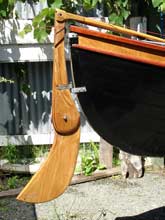 |
(Photo 1: the rudder fully down. Not shown in any of the photos is the strong length of shockcord which runs under tension from high up the leading edge of the rudder along the front of the stock and is secured near the tiller. In other words the default position of the rudder is down.)
(click images for larger views) |
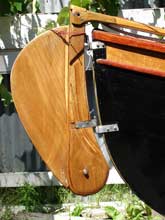 |
(Photo 2: The rudder fully up; showing why John calls it a "clasp-knife rudder." The shockcord is just visible as a dark line under the tiller.) |
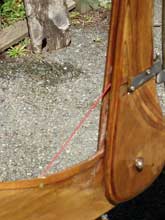 |
(Photo 3: The lifting line is visible here; it runs into the boat handy to the rower and is secured there.) |
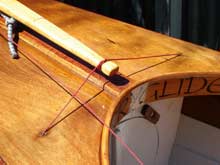 |
(Photo 4: The tiller simply forms a lever arm to give the tiller lines some leverage over the rudder and is never used as a conventional tiller. |
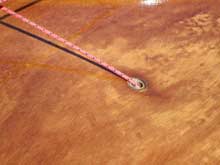 |
(Photo 5: The lines pass through the deck via inset copper tubes. |
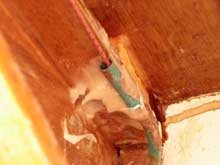 |
(Photo 6: This shows the underside of the deck. |
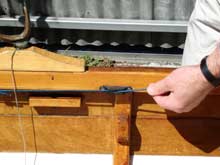 |
(Photo 7: The lines then run back to clam cleats each side of the rower, where they are readily adjusted for the conditions. Arguably the rudder functions as an adjustable skeg when used this way) |
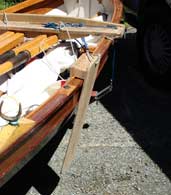 |
(Photo 8: the clip-on leeboard John made as an experiment has been entirely successful) |
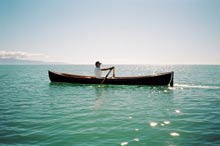 |
(Photo 9: rowing with the rudder down off the Nelson coast) |
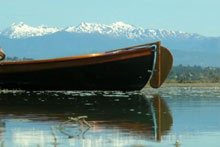 |
Photo 10: Unnecessary in these conditions: the rudder raised on Lake Rotoiti, Nelson Lakes National Park. |
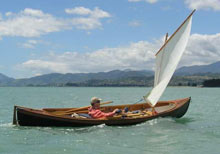 |
(Photo 11: When sailing John sits in the bottom of the boat with a line over each shoulder to control the rudder. (Credit: Steve Bagley. Running the Waimea Estuary near Nelson.) |
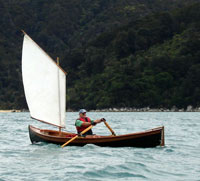 |
(Photo 12 John row-sailing Ferryglide on a grey day off Abel Tasman National Park. |
In conditions such as photos 10 & 12, John can row at (GPS verified) a steady 7 kilometres per hour ( 4.3 mph) for a couple of hours at a time.
The rudder has greatly enhanced his use of the boat and is a elegant solution without any downside.
|

